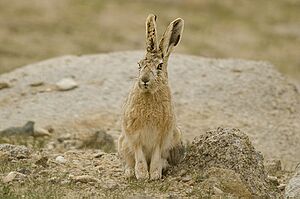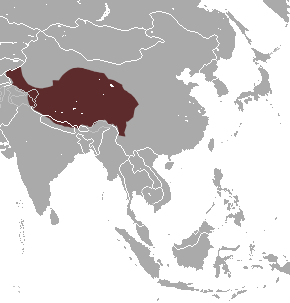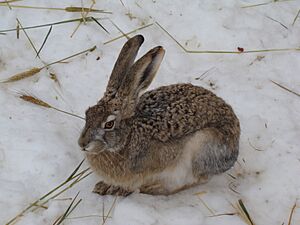Woolly hare facts for kids
Quick facts for kids Woolly hare |
|
|---|---|
 |
|
| at Polakongka La, Ladakh, India | |
| Conservation status | |
| Scientific classification | |
| Genus: |
Lepus
|
| Species: |
oiostolus
|
 |
|
| Woolly hare range | |
The woolly hare (Lepus oiostolus) is a type of mammal that belongs to the rabbit and hare family. You can find these hares in western and central China, northern India, and Nepal. They usually live in grassy areas high up in the mountains.
This hare species is found across a wide area, and some live in special protected zones. Even though they are not very common, a big nature group called the International Union for Conservation of Nature says they are a "least concern" species. This means they are not currently in danger of disappearing.
Contents
What Does a Woolly Hare Look Like?
The woolly hare can grow to be about 40 to 58 centimeters (16 to 23 inches) long. Imagine a ruler and a half – that's how long they can be! Their fur coat changes only once a year.
Where Do Woolly Hares Live?
Woolly hares are native to parts of Central Asia. Their home stretches from northern Nepal, and areas like Jammu and Kashmir and Sikkim in India. They also live across western and central China, in provinces such as Gansu, Qinghai, Sichuan, Tibet, Xinjiang, and Yunnan.
Woolly Hare Habitat
These hares mostly live in high-altitude grasslands. This includes alpine meadows, shrubby meadows, and cold deserts found in the mountains. Sometimes, they can also be found in forests with pine trees or mixed trees in the mountains. They live at heights from about 3,000 to 5,300 meters (9,800 to 17,400 feet) above sea level. That's really high up!
Woolly Hare Life and Habits
The woolly hare is a shy animal and usually prefers to be alone. While they might be active during the day sometimes, they are mostly nocturnal, meaning they are active at night.
What Do Woolly Hares Eat?
Woolly hares eat grasses and other small plants. Each hare often goes back to the same places to find food every night. During the day, they sometimes rest in a sunny, sheltered spot.
Woolly Hare Reproduction
The breeding season for woolly hares begins in April. Female hares usually have two litters of babies each year. Each litter can have between four and six young hares.
Conservation Status of the Woolly Hare
The woolly hare lives in many places, but it's generally not a common animal. Its population is described as "very low" except in a few special areas where they thrive.
Threats to Woolly Hares
People sometimes hunt woolly hares for their meat and fur. In some places, the areas where they live are being destroyed. This causes groups of hares to become separated, making it harder for them to move around in their local areas.
Protection Efforts
In Nepal and China, some woolly hares live in protected areas. Overall, the International Union for Conservation of Nature says the woolly hare is a "least concern" species, meaning it's not in immediate danger. However, in India, it is considered an "endangered" species, which means it's in danger of disappearing there.



